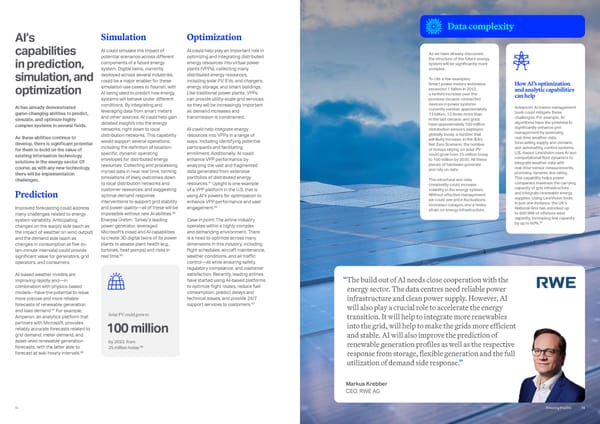AI has already demonstrated game-changing abilities to predict, simulate, and optimize highly complex systems in several fields. As these abilities continue to develop, there is significant potential for them to build on the value of existing information technology solutions in the energy sector. Of course, as with any new technology, there will be implementation challenges. AI’s capabilities in prediction, simulation, and optimization Simulation AI could simulate the impact of potential scenarios across different components of a future energy system. Digital twins, currently deployed across several industries, could be a major enabler for these simulation use cases to flourish, with AI being used to predict how energy systems will behave under different conditions. By integrating and leveraging data from smart meters and other sources, AI could help gain detailed insights into the energy networks, right down to local distribution networks. This capability would support several operations, including the definition of location- specific, dynamic operating envelopes for distributed energy resources. Collecting and processing myriad data in near real time, running simulations of likely outcomes down to local distribution networks and customer resources, and suggesting optimal demand response interventions to support grid stability and power quality—all of these will be impossible without new AI abilities.89 Enerjisa Üretim, Turkey’s leading power generator, leveraged Microsoft's cloud and AI capabilities to create 3D digital twins of its power plants to assess plant health (e.g., turbines, heat pumps) and risks in real time.90 Prediction Improved forecasting could address many challenges related to energy system variability. Anticipating changes on the supply side (such as the impact of weather on wind output) and the demand side (such as changes in consumption at five-to- ten-minute intervals) could provide significant value for generators, grid operators, and consumers. AI-based weather models are improving rapidly and—in combination with physics-based models—have the potential to issue more precise and more reliable forecasts of renewable generation and load demand.87 For example, Amperon, an analytics platform that partners with Microsoft, provides reliably accurate forecasts related to grid demand, meter demand, and asset-level renewable generation forecasts, with the latter able to forecast at sub-hourly intervals.88 Optimization AI could help play an important role in optimizing and integrating distributed energy resources into virtual power plants (VPPs), collecting many distributed energy resources, including solar PV, EVs, and chargers, energy storage, and smart buildings. Like traditional power plants, VPPs can provide utility-scale grid services, so they will be increasingly important as demand increases and transmission is constrained. AI could help integrate energy resources into VPPs in a range of ways, including identifying potential participants and facilitating enrollment. Additionally, AI could enhance VPP performance by analyzing the vast and fragmented data generated from extensive portfolios of distributed energy resources.91 Uplight is one example of a VPP platform in the U.S. that is using AI’s powers for optimization to enhance VPP performance and user engagement.92 Case in point: The airline industry operates within a highly complex and demanding environment. There is a need to optimize across many dimensions in this industry, including flight schedules, aircraft maintenance, weather conditions, and air traffic control—all while ensuring safety, regulatory compliance, and customer satisfaction. Recently, leading airlines have started using AI-based platforms to optimize flight routes, reduce fuel consumption, predict delays and technical issues, and provide 24/7 support services to customers.93 Solar PV could grow to by 2023, from 25 million today 85 100 million Data complexity As we have already discussed, the structure of the future energy system will be significantly more complex. To cite a few examples: Smart power meters worldwide exceeded 1 billion in 2022, a tenfold increase over the previous decade; connected devices in power systems currently number approximately 13 billion, 13 times more than in the last decade; and grids have approximately 320 million distribution sensors deployed globally today, a number that will likely increase. In the IEA’s Net Zero Scenario, the number of homes relying on solar PV could grow from 25 million today to 100 million by 2030. All these pieces of hardware generate and rely on data. This structural and data complexity could increase volatility in the energy system. Without effective management, we could see price fluctuations, increased outages, and a heavy strain on energy infrastructure. How AI’s optimization and analytic capabilities can help Advanced AI-based management tools could mitigate these challenges. For example, AI algorithms have the potential to significantly enhance grid management by assessing real-time weather data, forecasting supply and demand, and automating control systems. U.S.-based LineVision uses AI and computational fluid dynamics to integrate weather data with real-time sensor measurements, providing dynamic line rating. This capability helps power companies maximize the carrying capacity of grid infrastructure and integrate renewable energy supplies. Using LineVision tools, in just one instance, the UK’s National Grid has unlocked up to 600 MW of offshore wind capacity, increasing line capacity by up to 60%.94 Markus Krebber CEO, RWE AG “ The build out of AI needs close cooperation with the energy sector. The data centres need reliable power infrastructure and clean power supply. However, AI will also play a crucial role to accelerate the energy transition. It will help to integrate more renewables into the grid, will help to make the grids more efficient and stable. AI will also improve the prediction of renewable generation profiles as well as the respective response from storage, flexible generation and the full utilization of demand side response.” 54 Powering Possible 53
 Powering Possible 2024: AI and Energy for a Sustainable Future Page 27 Page 29
Powering Possible 2024: AI and Energy for a Sustainable Future Page 27 Page 29